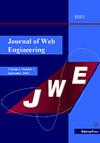A Web Engineering-Based Robust Watermark Restoration and Recognition Method for Protecting Online Video Content
IF 1
4区 计算机科学
Q4 COMPUTER SCIENCE, SOFTWARE ENGINEERING
引用次数: 0
Abstract
With the rapid expansion of over-the-top (OTT) services and web-based video streaming platforms, copyright protection has become a critical concern. Unauthorized redistribution and modification of digital content via composite transformations and distortions threaten content security. While watermarking and digital rights management (DRM) offer protection, existing methods often fail under real-world web-based attack scenarios. In this paper, we present a web engineering-based robust watermark restoration and recognition method to enhance the security of online video content. Our approach employs AKAZE feature detection to extract robust feature points, while a discrete wavelet transform (DWT) is used for subband decomposition, embedding the watermark in the lowest-energy subband near the detected feature points. To ensure resilience against distortions common in web environments, we evaluate our method under four types of noise (Gaussian, salt-and-pepper, uniform, and Poisson) and four rotation angles (0°, 90°, 180°, and 270°). AKAZE-based feature matching compensates for rotation distortions, while noise removal is handled using Gaussian, Median, or BM3D filtering. Performance evaluation using the peak signal-to-noise ratio (PSNR), structural similarity index measure (SSIM), normalized correlation (NC), and bit error rate (BER) confirms the effectiveness of our method. Results show that BM3D filtering achieves the highest average NC (0.8996) and the lowest BER (0.1137), demonstrating strong robustness against composite transformation attacks. This study contributes to web-based video security by integrating feature-based watermarking techniques with web engineering principles, ensuring effective protection for modern web applications.基于Web工程的在线视频内容鲁棒水印恢复与识别方法
随着OTT (over-the-top)服务和基于网络的视频流媒体平台的迅速发展,版权保护已成为一个关键问题。未经授权的再分发和通过复合转换和扭曲修改数字内容威胁到内容安全。虽然水印和数字版权管理(DRM)提供了保护,但在现实世界中基于web的攻击场景下,现有的方法往往失败。本文提出了一种基于web工程的鲁棒水印恢复与识别方法,以提高在线视频内容的安全性。该方法采用AKAZE特征检测提取鲁棒特征点,同时采用离散小波变换(DWT)进行子带分解,将水印嵌入到检测到的特征点附近能量最低的子带中。为了确保对网络环境中常见的扭曲的弹性,我们在四种类型的噪声(高斯噪声、椒盐噪声、均匀噪声和泊松噪声)和四种旋转角度(0°、90°、180°和270°)下评估了我们的方法。基于akaze的特征匹配补偿旋转扭曲,而噪声去除使用高斯,中值或BM3D滤波处理。使用峰值信噪比(PSNR)、结构相似指数(SSIM)、归一化相关(NC)和误码率(BER)进行性能评估,证实了该方法的有效性。结果表明,BM3D滤波的平均NC值最高(0.8996),误码率最低(0.1137),对复合变换攻击具有较强的鲁棒性。本研究通过将基于特征的水印技术与网络工程原理相结合,为网络视频安全做出了贡献,确保了对现代网络应用的有效保护。
本文章由计算机程序翻译,如有差异,请以英文原文为准。
求助全文
约1分钟内获得全文
求助全文
来源期刊

Journal of Web Engineering
工程技术-计算机:理论方法
CiteScore
1.80
自引率
12.50%
发文量
62
审稿时长
9 months
期刊介绍:
The World Wide Web and its associated technologies have become a major implementation and delivery platform for a large variety of applications, ranging from simple institutional information Web sites to sophisticated supply-chain management systems, financial applications, e-government, distance learning, and entertainment, among others. Such applications, in addition to their intrinsic functionality, also exhibit the more complex behavior of distributed applications.
 求助内容:
求助内容: 应助结果提醒方式:
应助结果提醒方式:


